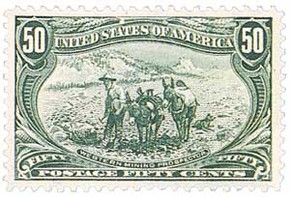
U.S. #285
1898 1¢ Trans-Mississippi Exposition
Quantity issued: 70,993,400 (unknown quantity later destroyed)
First Day of Issue: June 17, 1898
Printed by: Bureau of Engraving and Printing
Method: Flat Plate
Watermark: Double-line watermar... more
U.S. #285
1898 1¢ Trans-Mississippi Exposition
Quantity issued: 70,993,400 (unknown quantity later destroyed)
First Day of Issue: June 17, 1898
Printed by: Bureau of Engraving and Printing
Method: Flat Plate
Watermark: Double-line watermark USPS
Perforation: 12
Color: Yellow green
The 1¢ Trans-Mississippi Exposition stamp pictures Father Jacques Marquette preaching to a group of Native Americans. The design is based on a William Lamprecht painting owned by Marquette University in Milwaukee, Wisconsin.
Marquette (1637-1675) was a French Jesuit missionary and the founder of Michigan’s first European settlement, Sault Ste. Marie. In 1673, Marquette and Louis Jolliet were the first explorers to map the northern portion of the Mississippi River.
The stamp features the same border as the rest of the values. Unlike the 1893 Columbian series, the Trans-Mississippi Exposition commemoratives didn’t include the name or dates of the event. Instead, each stamp features a caption with the name of the photograph or painting upon which its design is based.
Printed by the Bureau of Engraving and Printing
The Trans-Mississippi commemorative stamps were printed by the Bureau of Engraving and Printing. Original plans called for the series to be printed in bi-color. However, the Spanish-American War strained the resources of the Bureau of Engraving and Printing, which was overburdened by the demand for revenue stamps to fund the war. The Trans-Mississippi commemoratives were printed in a single color, with the 1¢ denomination printed with yellow green ink.
About the 1898 Trans-Mississippi Exposition Series
The 1898 Trans-Mississippi and International Exposition was held to further the progress and development of natural resources west of the Mississippi River. Held in Omaha, Nebraska, the exposition opened on June 1, 1898, and ran for four months. More than 4,000 exhibits showcased social, economic, and industrial resources of the American West. The expo wasn’t a financial success overall, but it did revitalize Omaha, a community that had been devastated by drought and depression.
Over 2.6 million people attended the expo, which featured the Indian Congress, the largest Native American gathering of its kind. Over 500 members representing 28 tribes camped on the fairgrounds and introduced Americans from the East to their way of life. Reenactments of the explosion of the battleship Maine also fueled patriotism and support for the Spanish-American War.
The series is also referred to as the “Omahas” because the show was held in the city of Omaha. The 1¢ denomination paid the postcard rate and also was used on overweight letters. An unknown quantity of unsold stamps was recalled and destroyed.
First Building In Chicago
On December 4, 1674, Father Marquette erected the first building in what would later become Chicago.
Born in France in 1637, Jacques Marquette joined the Jesuits at the age of 17. He spent several years working and studying in France before being sent to New France as a missionary to the Indian population.
In 1668, Marquette was tasked with traveling down the St. Lawrence River in the western Great Lakes to establish new missions. During this trip, he created missions at Sault Sainte Marie and La Puente. While in La Puente, Marquette learned from the natives about a major trade route along the Mississippi River. The locals encouraged him to travel down the river to spread his mission, but a war between different nations forced him to leave the area and return to the Straits of Mackinac.
Once there, Marquette told his superiors about the Mississippi River and requested to take an expedition to explore it. In 1673, he received approval and was sent on an expedition led by Louis Jolliet. They traveled along the east coast of Lake Michigan, up the lower Fox River, across Lake Winnebago, and up the upper Fox River. When they stopped at the Wisconsin River, their two Indian guides left them, out of fear of river monsters.
Marquette and Joliet then continued on their journey, becoming the first Europeans to explore the northern Mississippi. They came upon one tribe that warned them not to go further because some of the other nations wouldn’t show them mercy and that the river was home to dangerous monsters that ate entire canoes. Marquette thanked them for their concern but said that he had to continue because “the salvation of souls was at stake, for which I would be delighted to give my life.”
The pair resumed their exploration and Marquette founded a mission among the Illinois Indians. After returning home, Marquette embarked on another missionary journey. In late December 1674, he and two companions were caught in a bad winter storm on Lake Michigan.
On December 4, they built a log cabin to protect themselves from the elements – creating the first temporary European settlement in what would eventually become Chicago. Father Marquette died the following year at the age of 37 from dysentery.

















